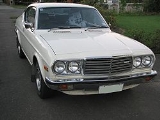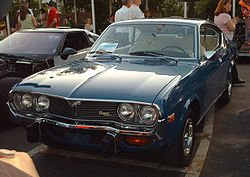
Mazda RX-4
Encyclopedia

Automobile
An automobile, autocar, motor car or car is a wheeled motor vehicle used for transporting passengers, which also carries its own engine or motor...
sold in the 1970s. It was a larger car than its rotary
Wankel engine
The Wankel engine is a type of internal combustion engine using an eccentric rotary design to convert pressure into a rotating motion instead of using reciprocating pistons. Its four-stroke cycle takes place in a space between the inside of an oval-like epitrochoid-shaped housing and a rotor that...
-powered contemporaries, the Capella
Mazda Capella
The second generation rear-wheel drive Capella was available between 1978 and 1982, in both sedan and coupe forms. It was known on export markets as the Mazda 626, with the exception of the United Kingdom, where it was called the Mazda Montrose, the name was changed to honour the local Mazda...
-based RX-2
Mazda RX-2
The Mazda RX-2 was a midsize car introduced in 1970 and sold through 1978. It used a rotary engine and shared a chassis with the piston-engined Mazda Capella/616/618....
and Familia
Mazda Familia
Mazda's automotive plans for the early sixties consisted of growing alongside the Japanese economy. To achieve this goal, they began by building an extremely cheap Kei car, the R360 in 1960, planning on introducing gradually larger and pricier cars as the Japanese customers became able to afford them...
-based RX-3
Mazda RX-3
The Mazda RX-3 is an automobile sold in the 1970s. It was intended to be smaller and sportier than its brother, the RX-2/Capella Rotary. In 1972 all rotary engines had their die-cast rotor housing coated with a new process: The new Transplant Coating Process featured sprayed-on steel which is...
. It shared the Luce/929
Mazda Luce
Mazda used the Luce name on its largest sedans in Japan from 1969 until 1990. These vehicles were exported under a variety of names, including RX-4, 929, and Cosmo. The Luce nameplate was replaced by the Mazda Sentia name in 1991...
chassis, replacing the R130
Mazda Luce
Mazda used the Luce name on its largest sedans in Japan from 1969 until 1990. These vehicles were exported under a variety of names, including RX-4, 929, and Cosmo. The Luce nameplate was replaced by the Mazda Sentia name in 1991...
in October 1972, and was produced through October 1977. Its predecessor (the R130) and replacement (the rotary Luce Legato) were not sold in the United States. Mazda marketed the RX-4 as being sporty and luxurious with the RX-4 having the best of both worlds. This gave Mazda a well needed boost in the popularity of the Wankel engine unique to Mazda.
The RX-4 was initially available as a hardtop
Hardtop
A hardtop is a term for a rigid, rather than canvas, automobile roof. It has been used in several contexts: detachable hardtops, retractable hardtop roofs, and the so-called pillarless hardtop body style....
coupé
Coupé
A coupé or coupe is a closed car body style , the precise definition of which varies from manufacturer to manufacturer, and over time...
and sedan, with a station wagon
Station wagon
A station wagon is a body style variant of a sedan/saloon with its roof extended rearward over a shared passenger/cargo volume with access at the back via a third or fifth door , instead of a trunk lid...
launched in 1973 to replace the Savanna Wagon
Mazda Savanna
Mazda used the Savanna name on a number of rotary-powered sports cars in the Japan market.-1971:...
. Under the hood at first was a 130 hp 12A engine, but this was replaced by the larger 13B in 1974 producing 125 hp, for export. This engine was Mazda's new "AP" (for "anti-pollution") version, with much-improved emissions and fuel economy, but somewhat worse cold-starting behavior.
In South Africa it was produced until 1979, all years only with the 12A engine.
The car used an strut-type
MacPherson strut
The MacPherson strut is a type of car suspension system which uses the axis of a telescopic damper as the upper steering pivot. It is widely used in modern vehicles and named after Earle S. MacPherson, who developed the design.-History:...
independent suspension
Independent suspension
Independent suspension is a broad term for any automobile suspension system that allows each wheel on the same axle to move vertically independently of each other. This is contrasted with a beam axle, live axle or deDion axle system in which the wheels are linked – movement on one side affects...
in front with a live axle
Live axle
A live axle, sometimes called a solid axle, is a type of beam axle suspension system that uses the driveshafts that transmit power to the wheels to connect the wheels laterally so that they move together as a unit....
in the rear. Brakes were discs in front and drums in the rear. Curb weight
Curb weight
Curb weight or kerb weight is the total weight of a vehicle with standard equipment, all necessary operating consumables , a full tank of fuel, while not loaded with either passengers or cargo.This definition may differ from definitions used by governmental regulatory agencies or other...
was low at 2620 lb (1,188 kg) and the wheelbase fairly short at 99 in (2510 mm).
The body was freshened in 1976.
United States
For the United States market, the RX-4 was sold from 1974 through 1978, when the RX-7Mazda RX-7
Series 1 is commonly referred to as the "SA22C" from the first alphanumerics of the vehicle identification number. This series of RX-7 had exposed steel bumpers and a high-mounted indentation-located license plate, called by Werner Buhrer of Road & Track magazine a "Baroque depression."In 1980...
debuted. The 13B produced 110 hp and 117 lbft in United States emissions form. Base pricing was $4295, with the automatic transmission ($270) and air conditioning ($395) the only expensive options.
Road & Track
Road & Track
Road & Track is an American automotive enthusiast magazine. It is owned by Hearst Magazines, and is published monthly. The editorial offices are located in Newport Beach, California.-History:...
magazine was impressed, noting the car's improved fuel economy and price compared to the RX-3. This was notable, as the Wankel engine had suffered by the mid 1970s with a reputation as a gas-guzzler. Performance was good in a 1974 comparison test of six wagons, with an 11.7 s sprint to 60 mi/h and an 18 s/77.5 mph quarter-mile. The magazine noted that the wagon's brakes suffered from the extra 300 lb (136 kg) weight compared to the coupé.
The RX-4 was on Road & Track
Road & Track
Road & Track is an American automotive enthusiast magazine. It is owned by Hearst Magazines, and is published monthly. The editorial offices are located in Newport Beach, California.-History:...
magazine's Ten Best list for "Best Sports Sedan, $3500-6500" in 1975.
External links
- Mazda.com History of Rotary
- New York Rotary Association - New Yorks Biggest Rotary Engine Auto Club (NYRA)

